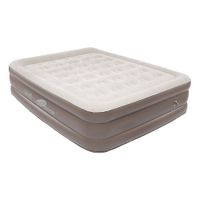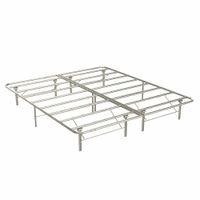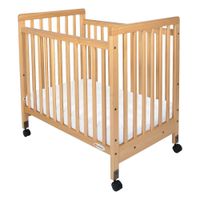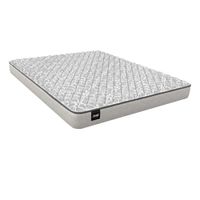Call +(254) 703 030 000 / 751 483 999 / 721 704 777
- Home
- Furnishings Appliances Hospitality
- Furniture
- Mattresses Bed Frames Bases
Frequently Asked Questions
What is the best type of mattress for back pain?
The best type of mattress for back pain is typically a medium-firm mattress. This type of mattress provides a balance between support and comfort, which is crucial for maintaining proper spinal alignment and reducing pressure points. A medium-firm mattress supports the natural curves of the spine, helping to alleviate pain by distributing body weight evenly and preventing the lower back from sinking too deeply.
Memory foam and latex mattresses are often recommended for back pain sufferers. Memory foam mattresses contour to the body's shape, providing personalized support and pressure relief. They help in maintaining spinal alignment by supporting the lumbar region. Latex mattresses, on the other hand, offer a responsive and slightly bouncy feel, which can be beneficial for those who change positions frequently during the night. They also provide good support and pressure relief, similar to memory foam, but with more breathability and durability.
Hybrid mattresses, which combine innerspring coils with layers of foam or latex, can also be a good option. They offer the support of traditional innerspring mattresses with the added comfort and pressure relief of foam or latex layers. This combination can be particularly beneficial for those who need the support of coils but also want the contouring benefits of foam.
Ultimately, the best mattress for back pain varies from person to person, depending on individual preferences, body weight, and sleeping position. It's important to consider personal comfort and to test different mattresses when possible. Additionally, consulting with a healthcare professional can provide guidance tailored to specific back pain issues.
How often should you replace your mattress?
You should replace your mattress every 7 to 10 years. This timeframe can vary based on several factors, including the type and quality of the mattress, your sleeping habits, and how well you maintain it. Higher-quality mattresses, such as those made from latex or high-density memory foam, may last longer, while innerspring mattresses might need replacement sooner.
Signs that indicate it's time to replace your mattress include visible sagging, lumps, or indentations, which can affect support and comfort. If you wake up with aches and pains or notice that you sleep better on other beds, it might be time for a new mattress. Allergies or asthma symptoms can also worsen if your mattress accumulates dust mites, mold, or allergens over time.
Proper maintenance can extend a mattress's lifespan. Regularly rotating and flipping (if applicable) your mattress, using a mattress protector, and ensuring proper support with a suitable bed frame can help maintain its condition. Additionally, keeping your mattress clean by vacuuming it and airing it out can prevent the buildup of allergens and dust.
Ultimately, personal comfort and health are the most important factors. If your mattress no longer provides a restful night's sleep, regardless of its age, it may be time to consider a replacement.
What size mattress should I get for my room?
To determine the appropriate mattress size for your room, consider the following factors:
1. **Room Size**: Measure your room dimensions. A twin or twin XL mattress (38"x75" or 38"x80") is suitable for small rooms or shared spaces. A full mattress (54"x75") fits well in medium-sized rooms, offering more space for a single sleeper. A queen mattress (60"x80") is ideal for master bedrooms or guest rooms, providing ample space for couples. A king (76"x80") or California king (72"x84") is best for large rooms, offering maximum space for couples or families with children or pets.
2. **Sleeping Arrangements**: Consider who will use the bed. A twin or full is sufficient for a single adult or child. A queen is versatile for couples or individuals who prefer extra space. A king or California king is perfect for couples who want more personal space or share the bed with children or pets.
3. **Room Layout**: Ensure the mattress size allows for comfortable movement and furniture placement. Leave at least 2-3 feet of space around the bed for easy access and to accommodate other furniture like nightstands or dressers.
4. **Budget**: Larger mattresses typically cost more. Balance your needs with your budget, considering both the mattress and potential additional costs for bedding and bed frames.
5. **Future Needs**: Consider potential changes, such as moving to a new home or changes in household size, which might affect your mattress choice.
By evaluating these factors, you can select a mattress size that fits your room, meets your sleeping needs, and aligns with your budget.
How do I choose the right bed frame for my mattress?
To choose the right bed frame for your mattress, consider the following factors:
1. **Size Compatibility**: Ensure the bed frame matches your mattress size (e.g., twin, full, queen, king). Measure your mattress and compare it with the frame dimensions.
2. **Support Type**: Decide between platform beds, which don't require a box spring, and traditional frames that do. Platform beds offer built-in slats or a solid base, while traditional frames need a box spring for support.
3. **Material**: Choose between wood, metal, or upholstered frames. Wood offers a classic look and durability, metal provides a modern aesthetic and is often more affordable, while upholstered frames add a touch of luxury and comfort.
4. **Style and Design**: Match the frame style with your bedroom decor. Consider headboard and footboard designs, color, and overall aesthetic to ensure it complements your room.
5. **Height**: Consider the frame height for ease of getting in and out of bed. Low-profile frames are modern and sleek, while higher frames offer more storage space underneath.
6. **Storage Needs**: If storage is a priority, opt for frames with built-in drawers or enough clearance for under-bed storage.
7. **Durability and Quality**: Check the frame's construction quality. Look for sturdy joints and high-quality materials to ensure longevity.
8. **Budget**: Set a budget and find a frame that offers the best value within your price range. Balance cost with quality and features.
9. **Ease of Assembly**: Consider how easy it is to assemble the frame. Some may require professional assembly, while others are DIY-friendly.
10. **Warranty and Return Policy**: Check the warranty and return policy for peace of mind in case of defects or dissatisfaction.
Are adjustable bases worth the investment?
Adjustable bases can be a worthwhile investment for many individuals, depending on their specific needs and preferences. These bases offer customizable sleeping positions, which can enhance comfort and support. For people with medical conditions such as acid reflux, sleep apnea, or chronic pain, adjustable bases can provide significant relief by allowing them to elevate their head or legs, improving circulation and reducing pressure points.
Moreover, adjustable bases can enhance the overall sleep experience by offering features like massage functions, USB ports, and under-bed lighting. These added conveniences can contribute to a more restful and enjoyable sleep environment. For couples, the ability to adjust each side of the bed independently can be particularly beneficial, accommodating different sleep preferences without disturbing the other person.
However, the cost of adjustable bases can be a consideration, as they are generally more expensive than traditional bed frames. It's important to weigh the potential health and comfort benefits against the financial investment. Additionally, not all mattresses are compatible with adjustable bases, so it may require purchasing a new mattress, adding to the overall cost.
In summary, adjustable bases can be a valuable investment for those seeking improved sleep quality, relief from certain health conditions, and added convenience. However, potential buyers should carefully consider their budget, compatibility with existing mattresses, and personal sleep needs before making a decision.
What is the difference between a box spring and a platform bed?
A box spring and a platform bed serve as foundations for mattresses but differ in structure, support, and design.
A box spring is a wooden or metal frame filled with springs or a metal grid, covered in fabric. It is designed to sit on a bed frame and provides a supportive, shock-absorbing base for a mattress. Box springs are typically used with innerspring mattresses to enhance comfort and extend the mattress's lifespan by absorbing impact and reducing wear. They also elevate the mattress, making it easier to get in and out of bed.
In contrast, a platform bed is a standalone bed frame with a solid or slatted surface that directly supports a mattress without the need for a box spring. Platform beds are versatile, accommodating various mattress types, including memory foam, latex, and hybrid. They offer a modern, minimalist aesthetic and often include built-in storage options. The slats or solid base provide firm support, which can be beneficial for those who prefer a firmer sleeping surface.
The choice between a box spring and a platform bed depends on personal preference, mattress type, and desired bed height. Box springs are ideal for those who prefer a traditional setup and have an innerspring mattress, while platform beds suit those seeking a contemporary look and compatibility with different mattress types.
How can I make my guest bed more comfortable?
To make your guest bed more comfortable, start by investing in a high-quality mattress topper, such as memory foam or a featherbed, to add extra cushioning and support. Use soft, breathable sheets made from materials like cotton or bamboo, with a thread count of at least 300 for a luxurious feel. Add a variety of pillows with different firmness levels to cater to your guests' preferences, including hypoallergenic options for sensitive sleepers.
Layer the bed with a cozy duvet or comforter, and consider adding a quilt or blanket for additional warmth. Ensure the bedding is freshly laundered and smells inviting. Provide a selection of throws or extra blankets at the foot of the bed for guests who may need more warmth.
Pay attention to the bed's foundation; a sturdy bed frame or platform can enhance comfort. If the bed is a pull-out sofa or air mattress, ensure it is in good condition and properly inflated or supported.
Create a welcoming atmosphere by placing a bedside table with a lamp for reading, an alarm clock, and a charging station for electronic devices. Add personal touches like a small vase of fresh flowers, a carafe of water, and a few books or magazines.
Ensure the room is well-ventilated and at a comfortable temperature. Consider adding blackout curtains or blinds to help guests sleep better. Finally, provide a luggage rack or space for guests to store their belongings, ensuring the room is clutter-free and inviting.



